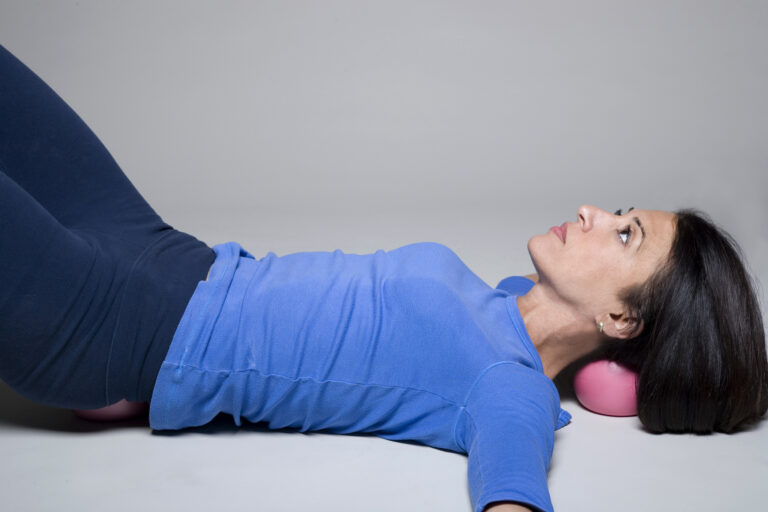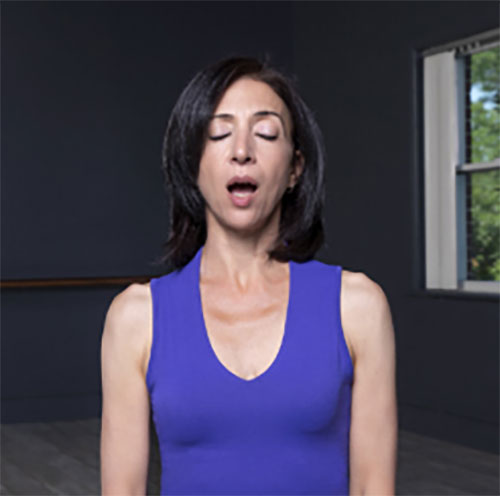TMJ: YOU Can’t Move What You Don’t Feel.
TMJ, commonly called your jaw, is associated with the discomfort this joint can sometimes cause. It stands for Temporomandibular joint. The Miracle Ball Method incorporates this area to improve breathing as well as ease up the stiffness that causes much of the discomfort of TMJ. Its one of those very strong muscular areas of the body that many of us don’t know is tight. I had a student once who clenched her jaw significantly. She didn’t know it until her dentist told her she was doing it, and the negative effects it was having on her teeth.
Many of us like to believe what we feel physically is accurate. But then why don’t we feel muscles when they are working so hard. In fact, the harder you work certain muscles the less feeling they have, until they cause pain. There are many parts of our body that this applies to. For example, many of us don’t realize when we are clenching our glutes or buttocks to the point of chronic backaches, and sciatic pain. Some of us tighten the muscles around our ribs and shoulders. There are many reasons for this and the benefits of alleviating it are significant. The puzzling thing for many when doing the Method is it asks you to feel, what you don’t feel.
The Good News
The Good news is you can begin to feel these parts of the body. It also feels great when you do. It will start to lower the tension in that area but also many of the surrounding areas. For example, the jaw is related to our shoulder tension, how we balance our head and neck, as well as our breathing. Once we do some simple things to relieve the excess tension, the body can begin to do the Miracle of the Method and make adjustments for us.
Our body knows where balance is. We just don’t let it go there.
Another great thing about becoming familiar with your jaw is you can do this almost anywhere without anyone noticing. And when you improve the way your jaw feels, many areas of the body will find relief.
Look for the feedback your body is giving you.
What you can do.
Here is something simple that you can add to your day. I would encourage you to follow the simple directions and go very easy. This way your body will feel the pleasure of this area. But never be surprised if you don’t feel anything. Its something that is working, but it is a very unfamiliar way of moving. We tend to “fight” movement rather than feel it.
Try this during your week:

- Begin by doing a Check In. Take a few seconds to notice anything that stands about to you about the way you are sitting or lying down.
- Gradually begin to open your mouth and use gravity, is there any weight you can sense (DON”T FORCE) to your jaw?
- Then slowly close your mouth, avoid licking it shut. Take a few moments, or longer to notice any change in your breathing. You may even notice the way you are sitting or lying down changing in some way.
- Repeat the above. Allow the weight of your jaw to perhaps hang a little heavier over time. Then gently exhale as if you are fogging up a window with your breath, the “H” sound.
- Take time to notice your responses. Even if you have no responses, that is a response. Do you notice breathing in any different parts of your body?
- Repeat The “H” Sound
- Try this for 5-7 minutes. You can do this during your day if you notice you are beginning to tighten your jaw again. Doing this brings a sense of options and it becomes easier to make choices that feel good!
Optional: Doing this during neck on the ball feels amazing. Its also something to do before you go to
sleep or when you wake up. I keep the ball behind my pillow. Feel the weight and let gravity help you.

Small Steps to change
Jaw tension is connected to many areas of the body. Over time this simple experience with your body will be something that not only gets easier but introduces you to how amazing your body is when taking small steps.
You can’t move what you don’t feel.
Quote of the week: Laura, a student in one of the classes said she had a question, “when I open my mouth I don’t feel anything and I keep doing it but I don’t feel anything when I do it “. She had a smile on her face, and oddly enough in her next class she began to feel the muscles around her jaw.
Everything we do with the method is the opposite of exercise. We assume a lot about our bodies when we move. But they are very similar to instruments, you must tune them up. What Laura said touched me because it was that first awareness I had, that led me on this journey decades ago. When I was asked what I noticed about my sitting at the time, I was completely confused. I noticed how I sat, but the teacher used that awareness, and then took me on a journey with my body. I didn’t do it all. I had to use what I did have, include the tools of the method, and then allow feedback.
Everyone had given me exercises for my back, and what they thought was sciatic pain. There was therapy, and gloom and doom diagnosis about my future. The only thing that made sense was I was going in completely the wrong direction. I had to work with my body. The only way to do that was to feel it. You can move what you don’t feel.
Come to my Free Webinar July 1
TMJ: You Can’t Move What You Don’t Feel. How one part of the body can improve the whole.
Sign up to Learn more
